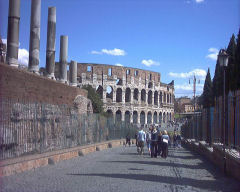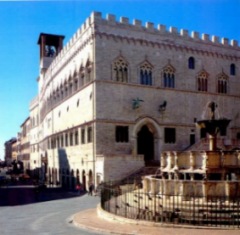ICSC 2006 - Travel Information
History of Rome
Rome and its numerous centuries of history officially begin in 753 B.C. on the slopes of the Palatino hills, when the Etruscans and Greek colonies occupied areas nearby. Tradition gave Romulus the paternity of the village, tracing in the boundary with a plow.
From 509 B.C. until 27 B.C., the republican supreme authority governed and was elected each year by the citizens, establishing the base of civil law.
Rome, once a village, became the capital of an empire in a few centuries and, with the Punic Wars, the undisputed ruler of the Mediterranean Sea.
The territorial and population expansion called for a redefinition of the "republic", or the state. After the assassination of Caesar (44 B.C.) affluent men disputed over the next successor of the new regime-the princedom: Marco Antonio, Cleopatra's ally, or Caesar's adopted son Octavian, both of who shared the rule after Caesar's death. The "princeps" (from primum caput" or "first citizen") founded an empire in a unified and peaceful order that lasted until the III century A.D. ("pax romana"). It was during these centuries that the Roman empire reached its splendor.
With the III century A.D. Rome gradually lost its central role as a kingdom of vastness and universality, until Diocletian separated the empire into two parts, profoundly restructuring economy, finance, politics, and bureaucracy. This guaranteed Rome a new century of prosperity while Christianity became officially authorized in 313 A.D. by Constantine the Great with the issued edict in Milan, contributing to the support of the regime.
In that period, Rome had about 4 million citizens (free men, slaves excluded) and an empire of over 50 million.
In the IV century the nucleus of the empire began to move toward the orient, after successive invasions by Barbarians, Visigoths, and Vandals, that also came to plunder the city of Rome.
In the VI century, the Roman empire began to disappear, leaving its mark in history as having created and unified the so-called "civil world".
More Information: www.capitolium.org
History of Perugia
Since ancient times, Perugia was one of the major Umbrian centres because of its strategic position, which allowed it to control communication routes.
Evidence of the civilisation and the prosperity of Perugia can be found in the large number of archaeological finds. These finds provide proof of the existence of a lively and resourceful people who lived in peace within an invincible fortress. This fortress was also a meeting point for intense commercial exchange.
The Etruscans conquered it in the 6th cent. b.C. and Perugia became one of the twelve most important cities of the Etruscan federation.
The Etruscan-Perugia, for a long period of time, opposed Roman expansion into Umbria and only in 217 b.C. definitively established alliance with Rome, who assigned Perugia the title of Municipality.
After a period of relative calm, Perugia became involved in the Civil War between Octavian and Mark Anthony. Octavian won (40 b.C) and destroyed Perugia, allied to his brother Anthony.
Later, Octavian, by then Augustus, rebuilt the city and named it "Augusta Perusia" and brought Perugia to a new splendour.
With the fall of the Roman Empire, Perugia was subjected to the barbarian invasions and was destroyed by the Goths of Totila (547 a.C.). It was then conquered by the Byzantines and became stronghold against the expansion of the Longobard Duchy of Spoleto.
Perugia remained under Byzantine rule until the 8th cent. before being subjected to ecclesiastical rule. In the year 1000, it became a free commune and remained allied to the Papal State which held five conclaves fhere or the election of new Popes.
In the 14th cent., the alliance with the Church of Rome deteriorated completely when Perugia destroyed Foligno, allied to the Pope.
Pope Martin IV excommunicated all Perugini and from this period onwards the history of Perugia became a succession of internal power struggles, conspiracies, betrayals and wars which did not seize until Pope Paul III (1531) definitively took control.
From this moment, Perugia was deprived of every liberty and autonomy and all attempts of rebellion against the authority of the Pope were punished with new massacres and destruction.
In 1860, Perugia definitively became part of the Kingdom of Italy and from this moment its history is linked to that of Italy.
More Information: www.umbria2000.it




